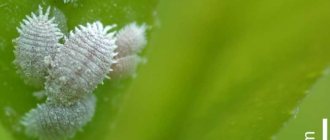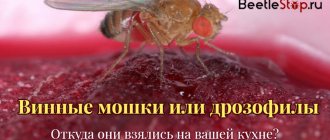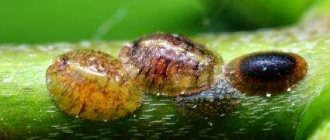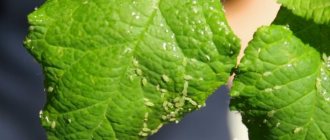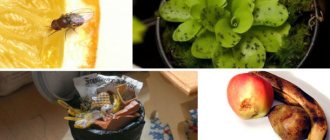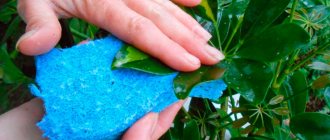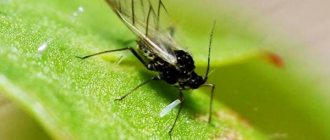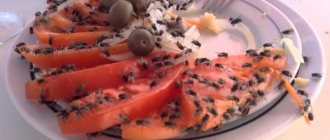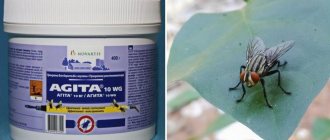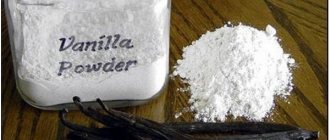Recently, potted plants have increasingly become a design choice.
They perform an aesthetic role, decorating the room, adding color at any time of the year. They are purchased for interior decoration of various rooms: children's rooms, kitchens, offices, halls.
However, house plants are not only about aesthetics and beauty. The benefits of a natural air purifier are much greater than those of an artificial one.
Potassium permangantsovka
When midges appear, you must first let the soil dry, and then replace the irrigation water with a weak solution of potassium permanganate. You only need a few grains per liter of water so as not to burn the roots. The plant can also be sprayed with this composition.
Potassium permanganate has a good effect in the fight against fungus in the soil. If you smell mold, dry the soil and water it with a pale pink solution.
It is not recommended to use the product on an ongoing basis. This can disrupt the acid-base balance of the soil and lead to the accumulation of manganese in the soil. As a result, not only pathogenic microorganisms will die, but also beneficial bacteria.
Who can live in a flower pot
There are a lot of pests for indoor flowers. Some of them settle in a land coma. When the housewife notices small whitish worms in the tray or near the stem, the plant must be rescued immediately. But first you need to determine what kind of parasite you will have to fight. These can be the larvae of some insects or adults. Let's list the possible options.
Nematodes
Protostomal roundworms. There are almost a million species in total, but only plant nematodes inhabit flower pots. These are very small whitish worms. They feed on plant debris or living greens.
Varieties of plant nematodes
Free. They can live on different parts of the plant body, moving from one place to another. They affect the entire bush. With free cyst formation. They settle in the roots, destroying their shell. They form root cysts or reservoirs with fertilized eggs. Gallic. They live on root shoots. They deposit secretions on them, which provoke the formation of galls or thickenings. Individuals settle inside them. Ripe eggs rupture the shell of the thickening, it bursts, the larvae crawl into the soil.
One of the signs of nematode infection is the appearance of rounded swellings on the root shoots. In addition, small areas of yellow color appear on the leaves. Subsequently they darken, become brown or black. The leaves are deformed and reduced in size, the stems are bent.
Enhytrea
Small, up to 10 mm long, translucent worms. They settle on the roots and do not rise to the surface. Therefore, it is difficult to notice the presence of enchytrea, unless by chance during the transplant process. In nature, they feed on decaying organic matter. But in a limited space, such as a flower pot, root shoots are eaten. If the colony size is large, the infected bush quickly dies.
You can suspect the presence of enchitraea based on indirect signs. The leaves begin to turn yellow, wither and fall off. The flower slows down and noticeably lags behind its healthy neighbors in development.
Having noticed this, you need to carefully remove it from the ground, as when replanting. In infected specimens, the roots are covered with enchytraea. Mechanical removal is useless; you need to look for an effective way to get rid of white worms in the ground.
Springtails
They are also called fools or springtails. Very small arthropods. The largest specimens reach 5 mm. Their peculiarity is the jumping fork located in the lower part of the body. With its help they are able to move quickly. Poduras feed on decaying organic matter; if it is not available, they switch to young shoots and roots.
The degree of damage caused depends on the size of the colony. If it is small, there is no threat to indoor flowers. But as soon as the number of pests increases, the greenery dies.
It is difficult to spot springtails. Most often, tiny white worms are found in the flower tray after watering, where they are washed away with water.
Otherwise, there are no specific signs of damage. The bush turns yellow and its growth slows down.
Sciarides
They are also fungus gnats or flower gnats. Adult specimens do not pose any danger to greenery. But the larvae living in the soil mixture destroy the root system. The plant slows down in growth, turns yellow and dies.
Infection can be suspected by the appearance of adult sciarids. These are small winged insects that circle around flower pots.
Their larvae are miniature white worms with a black head. The length of the individual is from 3 to 5 mm. Adult sciarids, when exposed to favorable conditions, such as warm and waterlogged soil, multiply quickly. Therefore, when the first midges appear, you must immediately begin to fight them. In the best case, they have not yet had time to lay eggs, then it will not be difficult to deal with them.
Landscape
10 garden plants that will help you no longer worry about pests in your area
Currently reading:
Tropics, forest and Van Gogh: 7 incredible interiors with…
Green sofa in the interior: which one to choose and with what...
What curtains are in fashion now: 7 trends for 2022...
Light walls and classic interior techniques:…
Sulfur from matches
Sulfur is part of complex fertilizers. In addition, fungicides based on this microelement are used for treatment at the first signs of a fungal disease.
To rid indoor flowers of pests, experienced flower growers stick matches into the ground with their heads down. After some time, the midges and their larvae will disappear, and the plant will receive almost free feeding.
The disadvantages of this method include the need to frequently change matches: the sulfur on them dissolves in one day. Wooden sticks left in the soil can rot and cause pathogenic flora to multiply.
Garlic
Strong antibacterial agent. Its smell cannot be tolerated by insects. If you are not afraid of a specific aroma, water your indoor flowers with garlic infusion.
Garlic destroys mold spores, prevents plant diseases and repels all insects. It is necessary to chop 7-10 cloves of garlic, pour a liter of boiling water over them and leave for at least a week.
Strain the resulting concentrate, measure out 50 g and stir in 10 liters of water. This solution can be used to both water and spray plants.
A simpler, but less effective way is to put a few cut cloves in a flower pot.
Advantages of using garlic: getting rid of pests, preventing plant diseases and saturating the soil with useful substances. The disadvantages include a pungent odor, the duration of preparation of the infusion and its short shelf life.
Reasons for the appearance of midges in flowers
Let's figure out why this problem arises - the appearance of midges in flowers
. There are several reasons why midges appear on plants; you should know them in order to properly care for your flowers.
First reason
– the soil was initially contaminated with midge larvae. Next time, remember that before planting plants in the soil, it must be disinfected.
In addition, the soil should be periodically treated against pests for prevention. This will prevent the appearance of parasitic colonies in the soil.
The second reason
– excessive waterlogging of the soil, especially in winter. This happens due to abundant and frequent watering - the water in the pot stagnates and contributes to the appearance of unwanted insects.
Third reason
– a constantly open window through which midges fly in and settle in the damp soil.
Fourth reason
– fallen leaves of plants that begin to rot in the pot, creating favorable conditions for the appearance of pests.
If you regularly carry out preventive disinfection of the soil and follow all the conditions for caring for plants, you will never have the question of how to get rid of midges from flowers in a pot.
Tobacco infusion
To prepare the product, tobacco dust, shag and dry tobacco leaves are suitable. Approximately 400 g of powder should be poured into 10 liters of water at room temperature and left for a day.
After a day, strain the mixture and spray it on indoor plants. Nicotine, which is part of tobacco, kills all insects.
To better retain the liquid on the leaves, you need to add a little laundry soap to the resulting composition.
Caution should be used: use a protective mask and store separately from food. Nicotine is a poison not only for insects, but also for humans.
It can cause dizziness, nausea, and heart rhythm disturbances. This substance is especially toxic to children and pets.
Cold
All insects love a warm and humid atmosphere, and cold has a depressing effect on them. Sometimes it is worth taking flower pots out onto the balcony, especially in early spring and late autumn.
The cold will not only destroy pests in the soil, but also harden the plants. First you need to find out which colors are indicated for such procedures. For example, geranium and fuchsia can easily tolerate temperature drops of up to 10 °C.
However, not all plants are so patient. Even a slight drop in temperature can cause the death of heat-loving tropical crops, in which case complex measures will have to be used to combat insects.
Lemon or lime zest
A cheap way to kill harmful insects is to use citrus peels. They will not only repel pests with volatile phytoncides, but will also become a vitamin supplement for the root system.
You need to break the lemon or lime peels into pieces and put them in a flower pot. This procedure should be carried out several days before the next watering, so that natural waste does not mold on wet soil.
The disadvantages of the method include the short duration of its action: when dried, citrus peel quickly loses its effectiveness.
Mosquito fumigator
The compositions that are filled with purchased fumigators are an excellent means of combating flower midges. They do not kill the larvae in the flower pot, but only repel insects for several hours or days.
In addition, they are used up quite quickly. Therefore, the method, despite its ease of use, is not the most effective.
The room must be ventilated from time to time to avoid dizziness, headaches and allergic reactions, which can be caused by low-quality products at a low price.
We recognize pests
First of all, you need to pay special attention to whether your plants have any pests, since they are the ones that can spoil the condition of potted flowers and sometimes even kill them.
The most common are small white bugs that spread very quickly throughout the flower. Before we talk about how to get rid of such “unexpected guests”, it is necessary to find out the reasons why small white insects appeared in the pot.
We tried to find out what factors contribute to their appearance:
- it is likely that small white insects in flower pots were blown onto the plants by the wind, by way of an open apartment window. Therefore, it is better not to place plants under direct wind flows from the street;
- Also, if you notice that strange white small insects have appeared in the soil of your flowers, photos of which on the Internet are labeled with various names - from aphids to thrips, the soil itself could be the reason for the appearance. Midge larvae could be brought in with soil, especially if it was not purchased in a specialized store, but was taken from the forest or garden;
- If there are small jumping midges in the pot, the reason for their spread could be waterlogging of the soil or the process of rotting caused by excessive watering of the plant.
Having found out the reasons for the appearance, we figured out how to prevent small white insects from appearing in the apartment. However, if such unexpected guests do appear, you need to be able to detect the problem at the first signs.
Insecticide
The most effective way to combat any harmful insects is the use of professional insecticides. Good results in pest control can be achieved with drugs containing imidacloprid or thiamethoxam. These substances are synthetic analogs of nicotine.
Based on them, many pest control products have been created. When sprayed, the drug penetrates the above-ground parts of the plant and remains there for a long time.
The substance itself does not harm plants, but kills insects that land on them. Worms and larvae living in the soil also die.
Like the use of any chemical pesticides, the use of such products can negatively affect the health of people and animals. Bio Spark is considered the safest drug containing a small dose of imidacloprid. When working with it, you must wear gloves and a respirator, and then thoroughly ventilate the room.
Chemicals for controlling midges
First, let's discuss chemicals.
Dichlorvos
– the main chemical remedy for midges in flowers. It could be Raptor, Raid or others. If the pests are in the soil, then place the plant in a plastic bag, spray the product on the surface of the ground and tie the bag at the base of the plant, without the outer part. Leave in this state for 5 hours.
You can also use special solutions against pests - Aktara, Fitoverm, Thunder 2, Fly eater, Karbofos, Bazudin, Tanrek.
Attention:
When using these drugs, do not forget about personal safety - use rubber gloves, safety glasses, and a respirator.
The drugs should be diluted strictly according to the instructions indicated on the packaging.
But such remedies are dangerous for both humans and plants, and they should be used when folk remedies, which we will discuss below, do not help.
Folk remedies for controlling midges
How to get rid of midges in flower pots using folk remedies? To prepare potent pest control products, we will need garlic, wood ash, hydrogen peroxide, potassium permanganate, laundry soap, tobacco, dill, matches, oranges.
All these ingredients are included in effective recipes.
Garlic
- according to reviews, it is the most effective remedy in the fight against midges; they cannot stand its smell.
Take a few cloves of garlic, peel, cut in half or into slices and place on top of the soil in the pot, you can deepen it a little.
Preparation of garlic infusion
- take 1 head of garlic, peel, chop and pour 1 liter of boiling water.
Leave to infuse for 3-4 hours, then strain. Pour the infusion into a spray bottle and spray all affected plants and pour the prepared mixture onto the ground.
Hydrogen peroxide 3%
- an excellent remedy (and plant food) in the fight against midges. Dilute 2 tablespoons of hydrogen peroxide in 1 liter of water. Spray the above-ground part of the plants with the resulting mixture and spill the soil in the pot. Peroxide kills both larvae and adult pests.
Potassium permangantsovka
– dilute a weak solution (pink) of potassium permanganate and water the soil as it dries. After a few days, repeat watering with potassium permanganate. The solution should be barely pink, otherwise there is a risk of burning the roots of the plants.
Orange peels
- an interesting recipe for fighting midges. Peel the orange, cut the peels into wide strips, dry and stick into the ground.
Laundry soap
- Pests are afraid of him. Finely chop or grate 20 grams of soap. Pour 1 liter of warm water and dissolve completely. Spray both the flowers themselves and the soil in the pot with this mixture.
Wood ash
– an effective method against annoying midges and their larvae. Just sprinkle the soil in the flowerpot, lightly loosen the top layer and wait. The pests will disappear within a few days.
Tobacco
- can also help in the fight against midges. Take 20 grams of tobacco and pour a 0.5 liter jar of water. Let it sit for 2 days, then add another 1 liter of water. Tobacco infusion has a detrimental effect on adult insects, but the larvae do not die.
Strain and spray the above-ground part of the plant with the resulting solution.
Cinnamon
- a good means of combating midges. Cinnamon slows down putrefactive processes, leaving the midge without food. Sprinkle ground cinnamon on the soil in the flowerpot.
Dill
– also affects flying insects. Place the dill sprigs on top of the soil in the pot and leave for 2 days. Then replace with new, fresh dill. This must be done until the midges disappear.
Matches
– the bottom line is that midges are afraid of sulfur. The matches are deepened into the ground with their heads down, the soil is watered a little and left for 2-3 days. Then pull them out and insert new ones. According to reviews, midges and their larvae should die after 7 days.
Celandine
– a tincture of this herb will get rid of midges. Take 100 g of dry celandine herb, pour 1 liter of boiling water, leave for 3-4 hours, strain. Spray the above-ground part of the plants.
Velcro for flies (fly trap)
– a device for catching adult midges. They fly to the bait and end up in a sticky substance from which they can’t get out. You can make such Velcro with your own hands.
Drying soil in a pot
- a great way to fight. Loosen the surface of the soil in the pot and do not water the flower until the soil is almost completely dry, but not less than 2 cm. Then, after drying, water the soil with a weak solution of potassium permanganate.
Treatment with folk remedies is the safest way to get rid of midges in indoor flowers. They are affordable, easy to prepare and use, and safe for people and animals.
Soil replacement -
If all of the above methods of dealing with midges do not help, the best way to get rid of them is to completely replace the soil in the pot with a new one. It is better to throw away the old soil completely, rinse the pot with hot water and treat it with a weak solution of potassium permanganate or soap solution.
If the soil is not purchased, you should calcine it in the oven at a temperature of 120 degrees for 30-40 minutes, after cooling, spread the soil on a newspaper on the table and add wood ash and beneficial bacteria (this can be yeast or preparations like Baikal EM).
Video - Midges in indoor flowers. How to get rid of midges?
Which method of controlling midges you use is up to you to decide, based on your own experience and preferences.

